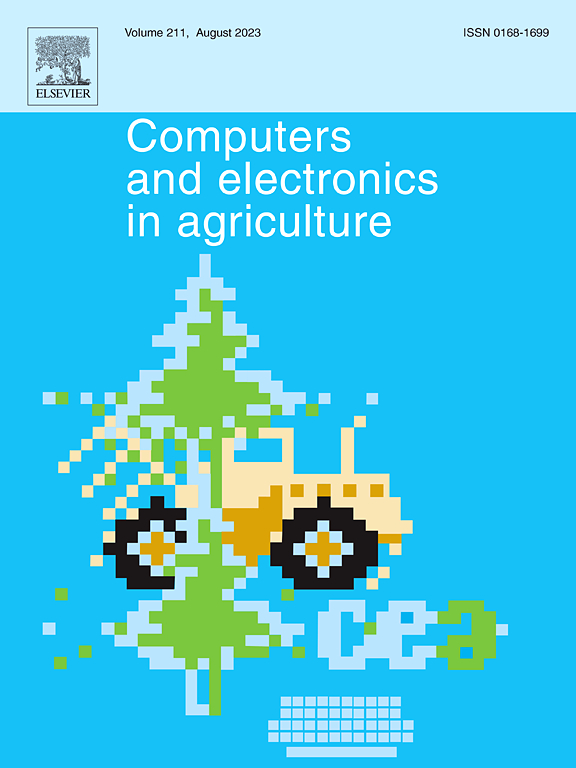下一代高通量表型与性状预测通过适应性多任务计算智能
IF 8.9
1区 农林科学
Q1 AGRICULTURE, MULTIDISCIPLINARY
引用次数: 0
摘要
表型定义了生物体的行为和物理属性,是遗传、发育和环境复杂相互作用的结果。由于这些动态的相互作用,预测植物未来的性状主要具有挑战性。这项研究提出了一种模块化方法 AMULET,它结合了基于成像的高通量表型分析和机器学习,可在植物形态和生理性状显现前数小时至数天对其进行预测。AMULET 使用 30,000 多株拟南芥植物进行训练,通过整合植物检测、预测、分割和数据分析,简化了表型分析流程,提高了工作流程效率,缩短了时间。AMULET 的性能指标令人印象深刻,包括测试集的骰子损失为 0.0104,IoU 得分为 0.9948,表明分割任务的准确性很高,描述符估计的 R2 得分为 0.9289。此外,在预测植物生长和健康状况方面,更简单、更好的视频预测(SimVP)是最有效的模型。AMULET 利用以拟南芥- 丁香假单胞菌病理系统为研究重点的表型图像,通过识别限制人类感知的特征来分析潜在表型,这些特征对于了解植物对具体生长条件的反应至关重要。TorchGrad 和梯度加权类激活图谱等技术帮助揭示了这些新的隐藏特征。AMULET 还证明了其适应性,只需对 100 株离体马铃薯植株进行微调,就能准确检测和预测其表型。这种多用途方法简化了表型分析,并通过先发制人的干预优化了植物健康和生产力,从而为改进育种计划和农业管理带来了巨大希望。本文章由计算机程序翻译,如有差异,请以英文原文为准。

Next-generation high-throughput phenotyping with trait prediction through adaptable multi-task computational intelligence
Phenotypes, which define an organism’s behaviour and physical attributes, result from the complex interplay of genetics, development, and environment. Predicting future plant traits is mainly challenging due to these dynamic interactions. This work presents AMULET, a modular approach that combines imaging-based high-throughput phenotyping and machine learning to predict morphological and physiological plant traits hours to days before they are visible. Trained with over 30,000 Arabidopsis thaliana plants, AMULET streamlines the phenotyping process by integrating plant detection, prediction, segmentation, and data analysis, enhancing workflow efficiency and reducing time. AMULET achieved impressive performance metrics, including a dice loss of 0.0104 and an IoU score of 0.9948 for the test set, indicating high accuracy in the segmentation task or an R2 score of 0.9289 for descriptor estimation. Moreover, Simpler yet Better Video Prediction (SimVP) appeared as the most effective model in predicting plant growth and health status. Using phenotyping images from studies focused on the Arabidopsis thaliana-Pseudomonas syringae pathosystem, AMULET analysed the latent phenom by identifying traits restrictive to human perception and essential to understanding plant response to concrete growth conditions. Techniques like TorchGrad and Gradient-weighted Class Activation Mapping helped to reveal these new hidden traits. AMULET also demonstrated its adaptability by accurately detecting and predicting phenotypes of in vitro potato plants after minimal fine-tuning with just 100 plants. This versatile approach streamlines phenotyping and holds significant promise for improving breeding programs and agricultural management by enabling pre-emptive interventions optimising plant health and productivity.
求助全文
通过发布文献求助,成功后即可免费获取论文全文。
去求助
来源期刊

Computers and Electronics in Agriculture
工程技术-计算机:跨学科应用
CiteScore
15.30
自引率
14.50%
发文量
800
审稿时长
62 days
期刊介绍:
Computers and Electronics in Agriculture provides international coverage of advancements in computer hardware, software, electronic instrumentation, and control systems applied to agricultural challenges. Encompassing agronomy, horticulture, forestry, aquaculture, and animal farming, the journal publishes original papers, reviews, and applications notes. It explores the use of computers and electronics in plant or animal agricultural production, covering topics like agricultural soils, water, pests, controlled environments, and waste. The scope extends to on-farm post-harvest operations and relevant technologies, including artificial intelligence, sensors, machine vision, robotics, networking, and simulation modeling. Its companion journal, Smart Agricultural Technology, continues the focus on smart applications in production agriculture.
 求助内容:
求助内容: 应助结果提醒方式:
应助结果提醒方式:


